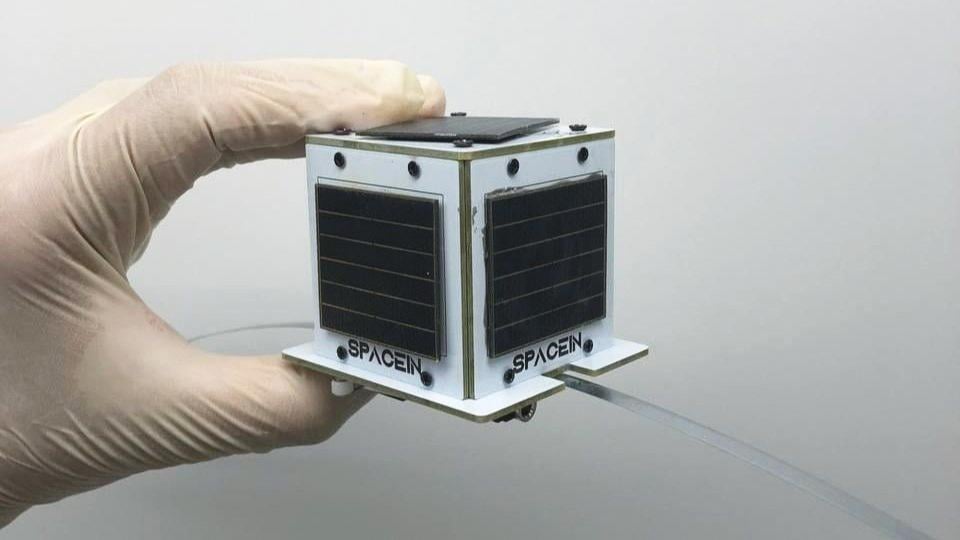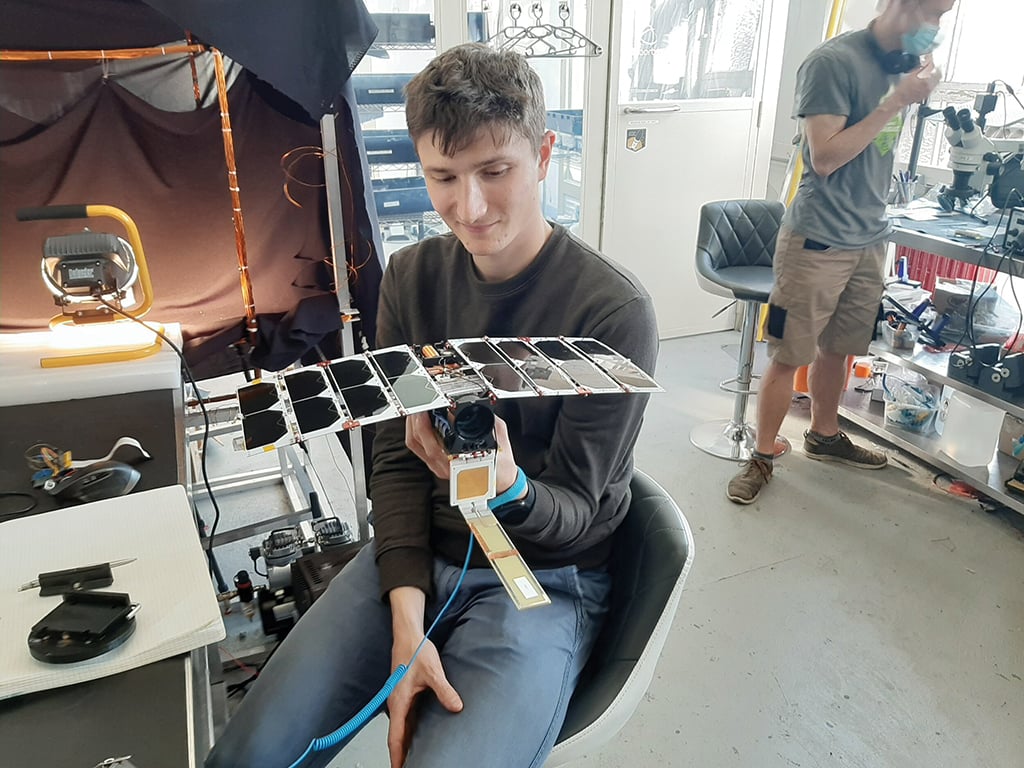
Because they have less volume and weight, PocketQubes are cheaper to launch.
The number of PocketQube satellites launched into orbit in the past several years has picked up significantly as academic institutions and startups have begun to experiment with the diminutive satellite buses, half the size of cubesats.
PocketQubes, measuring 5 X 5 X 5 cm (2 X 2 X 2 in.), were invented as a standardized satellite bus by Bob Twiggs, a now-retired professor at Morehead State University as well as a co-inventor of the space industry’s better-known small-satellite form factor, the cubesat. Cubesats are standardized, modular satellite buses that measure 10 X 10 X 10 cm per unit, created as a cheap and easy way for students to get their work into space. Since the first cubesat launched in 2003, thousands have followed, and the type has become popular with space companies and government institutions.
- Students and startups take to the standardized satellite
- Cubesat co-inventor Bob Twiggs created the PocketQube to drive down costs
Twiggs wonders if cutting the cubesat into even smaller portions might reduce costs again for students. “We can put eight [PocketQubes] in place of a cubesat,” he tells Aviation Week. “So does that mean we can bring their price down by a factor of eight?”
An initial batch of four PocketQubes was successfully launched into orbit in 2013. But from 2014 to 2018, the type was absent from launch vehicle manifests except for one failed attempt in 2018. The satellites got a second life in 2019 when six PocketQubes were launched. None followed suit in 2020, but then nine were launched in 2021 and 40 in 2022.
Whereas cubesats are measured in 10 X 10 X 10 cm “U” units, PocketQubes are measured in 5 X 5 X 5 cm “P” units. A single cubesat is designated 1U, and a single PocketQube is 1P. Cubesat units can be combined on two axes: width and length. PocketQubes can practically only be lengthened along a rail up to 3P, says Julian Fernandez, CEO of Fossa Systems of Spain, which makes a deployer for the Rubik’s cube-size spacecraft.
PocketQubes have recently taken off with the growth of ride-share missions onboard SpaceX’s Falcon 9 and Rocket Lab’s Electron launch vehicles. The recent introduction of launch brokers with specialized PocketQube deployers has also helped.
Launching a PocketQube into low Earth orbit can cost as little as $15,000, Fernandez says. The small satellites can be built for less than $1,000—or even for $50, as was the case of the $50SAT, which was developed and launched by Twiggs in 2013. PocketQubes tend to be a mix of academic classroom projects and experiments, as well as technology demonstrators from startups.
Fossa Systems has launched about a half dozen of its own 2P satellites to collect data from Internet of Things devices attached to industrial assets such as oil and gas infrastructure, electrical grid infrastructure and shipping containers.
For instance, shipping containers might send their location and temperature once per hour, Fernandez notes. “It’s low-data applications, which aren’t usually real-time,” he says. “We use it for monitoring assets worldwide, where there’s no connectivity, which is 80% of the planet.”
Fossa System’s PocketQubes could only transmit 10 kbps of data, mostly due to electric power limitations. However, some PocketQubes have been able to transmit 1 Mbps, Fernandez says. Despite the shrinking size of electronics, PocketQubes remain limited by their small volume and the number of solar panels they can carry.

“You’ve got to have the satellite off most of the time,” Fernandez says. “The experiments you run need to be very, very basic. Maybe take an image every day. Measure radiation.”
For those reasons, Fossa Systems has moved beyond PocketQubes and is developing future Internet of Things satellites with a thin variant of the cubesat, Fernandez says.
ACME AtronOmatic, the developer behind popular weather app MyRadar, has used PocketQubes to gain hands-on experience launching satellites. In 2022, PocketQube deployment company Alba Orbital deployed three 1P satellites for the company: MyRadar-1, TRSI-2 and TRSI-3.
ACME aimed to learn more about space hardware and regulatory compliance from the technology demonstration missions. It wants to reapply lessons learned for its planned 150-cubesat Hyperspectral Orbital Remote Imaging Spectrometer constellation, ACME CEO Andy Green says.
“We went with PocketQubes because they’re less expensive [and] they’re a little bit more expendable,” he says. “And we knew that these initial prototype missions were just to test out hardware to make sure that if we built a formal constellation, [we would be] production-ready.”
Alba Orbital, which hosted a PocketQube conference near its headquarters at Glasgow University Union in Scotland in December, also builds its own satellites and sees the potential for niche commercial operations.
“We do nighttime imaging on our satellites,” Alba Orbital CEO Tom Walkinshaw explains. Customers include the U.S. National Park Service and insurance companies, he says.
“We all have insurance customers that are interested in post-disaster insurance liability,” Walkinshaw notes. “They want to know really quickly after the tornado event what their liability is for insurance claims.”

Because PocketQubes are so small, there typically is no room for propulsion systems. Spacecraft are controlled with a reaction wheel and magnetorquer rods.
Their small size and inability to maneuver make PocketQubes a potential collision hazard. The U.S. Space Surveillance Network can reliably detect, track, identify and maintain custody of a baseball-size object in low Earth orbit and beach-ball-size objects in the geostationary range, the U.S. Space Force’s 18th Space Defense Sqdn. says.
“Smaller objects can be tracked, albeit with lower fidelity, thus we provide recommendations for owner-operators of smaller sats to help with tracking and identification, although we cannot dictate or enforce them,” the squadron says. “We recommend satellites have a minimum size of 1U and have detection enhancements.”
The squadron, which runs the public Space-Track.org database, is encouraging PocketQube operators to let it know about their launch plans and share data about their small satellites.
“Sharing this information ahead of time can help inform other owner-operators of risk before it’s encountered, such as selecting maneuver protocols during a conjunction due to a PocketQubes’ lack of maneuverability,” the squadron says.
The Space Force notes that active illumination with electromagnetic energy and deploying at higher inclinations also makes it easier to track the satellites.
Boosting the capabilities of PocketQubes requires more electrical power, which means more solar panels. To fit more solar panels onboard PocketQubes, developers would have to design complex storage and deployment mechanisms, however. Complexity increases costs. And if you’re going to pay more, you might as well develop and launch a cubesat, Fernandez says.
“I don’t think it’s going to move to commercial like cubesats have. Where [satellite developers] have the capacity to go to larger form factors, they could get more serious stuff done,” he says. “I think [PocketQubes have] really found their niche in first-comers and education.”






Comments